Aquascaping is a creative hobby that transforms your aquarium into a breathtaking underwater landscape. Imagine blending the natural beauty of plants, stones, and wood in a watery environment that’s not just a home for your fish, but a living work of art. The essence of aquascaping is found in its name, derived from ‘aquatic’ and ‘landscaping’, and you’re essentially gardening under water. As you embark on this adventure, you’ll learn to balance the aesthetic with the ecological, creating a harmonious environment that both pleases the eye and promotes healthy aquatic life.
This art form has blossomed in popularity, as more enthusiasts around the world find joy in crafting their own aquatic masterpieces. You become the artist, and your tank is the canvas. Your palette is rich with a variety of vibrant plants, rugged rocks, and gnarled driftwood, offering infinite combinations to express your vision. Whether you’re a beginner or looking to refine your craft, aquascaping is a delightful blend of nature and creativity that invites you to get your hands wet – quite literally.
Understanding Aquascaping
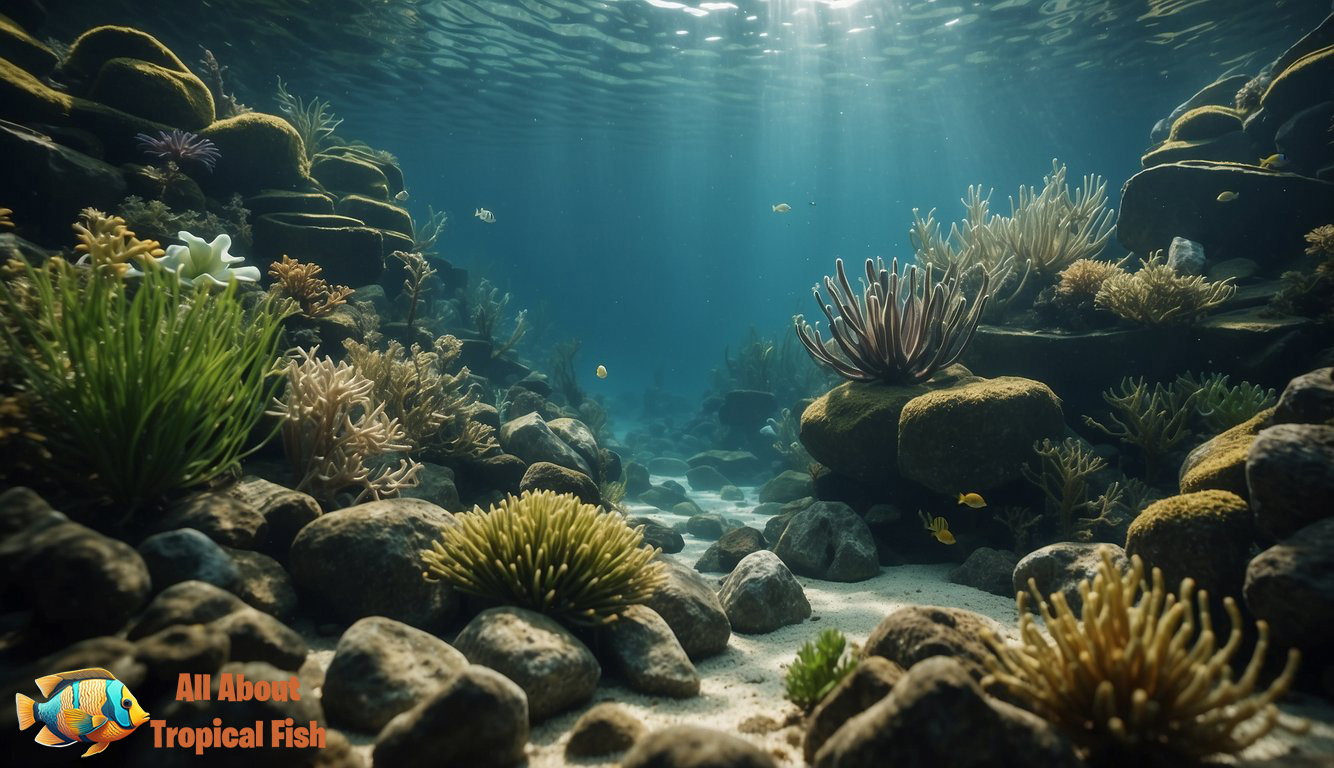
Aquascaping is a beautiful expression of art within an aquatic environment, where you can apply your creativity to design a natural landscape in miniature. we’ll talk about its origins, techniques, elements, and how it beautifully merges art with science.
Historical Background
Aquascaping has roots that can be traced back to the Japanese tradition of gardening and nature appreciation. It was later revolutionized by Takashi Amano, who introduced the Nature Aquarium concept, emphasizing the replication of terrestrial landscapes underwater.
Defining Aquascaping
Aquascaping is the artful arrangement of aquatic plants, rocks, driftwood, and substrate in an aquarium to create aesthetically pleasing scenes. It’s a blend of design, nature, and ecology, seeking to create a harmonious, balanced ecosystem.
Aquascaping Styles
Several styles exist within aquascaping, each with unique characteristics:
- Iwagumi: This minimalist style focuses on the strategic placement of rocks as the main feature.
- Dutch Style: Known for its abundant plant use, creating lush, colorful landscapes without much emphasis on hardscape.
- Nature Aquarium: Inspired by natural scenes, this style prioritizes harmony and balance.
- Jungle Style: Features dense vegetation, simulating a wild, untamed natural environment.
Essential Principles
Principles of design such as balance, focus, and contrast are key. Utilizing the golden ratio and the rule of thirds (photography terminology) helps in creating visually appealing compositions that guide the viewer’s eye naturally through the aquascape.
Components of Aquascaping
The main components include:
- Hardscape Materials: Rocks and driftwood provide structure and form the skeleton of the design.
- Aquatic Plants: These are crucial for adding life, color, and texture.
- Substrate: A base layer for plant roots and for aesthetic groundwork.
- Light: It’s not just functional for plant growth—it’s also essential for highlighting design elements.
Aquascaping as Art and Science
Aquascaping is an intersection of creativity and scientific knowledge. While art principles guide the aesthetical aspect, a deep understanding of water chemistry, lighting, and ecology ensures the health and growth of the aquatic life within.
Designing an Aquascape
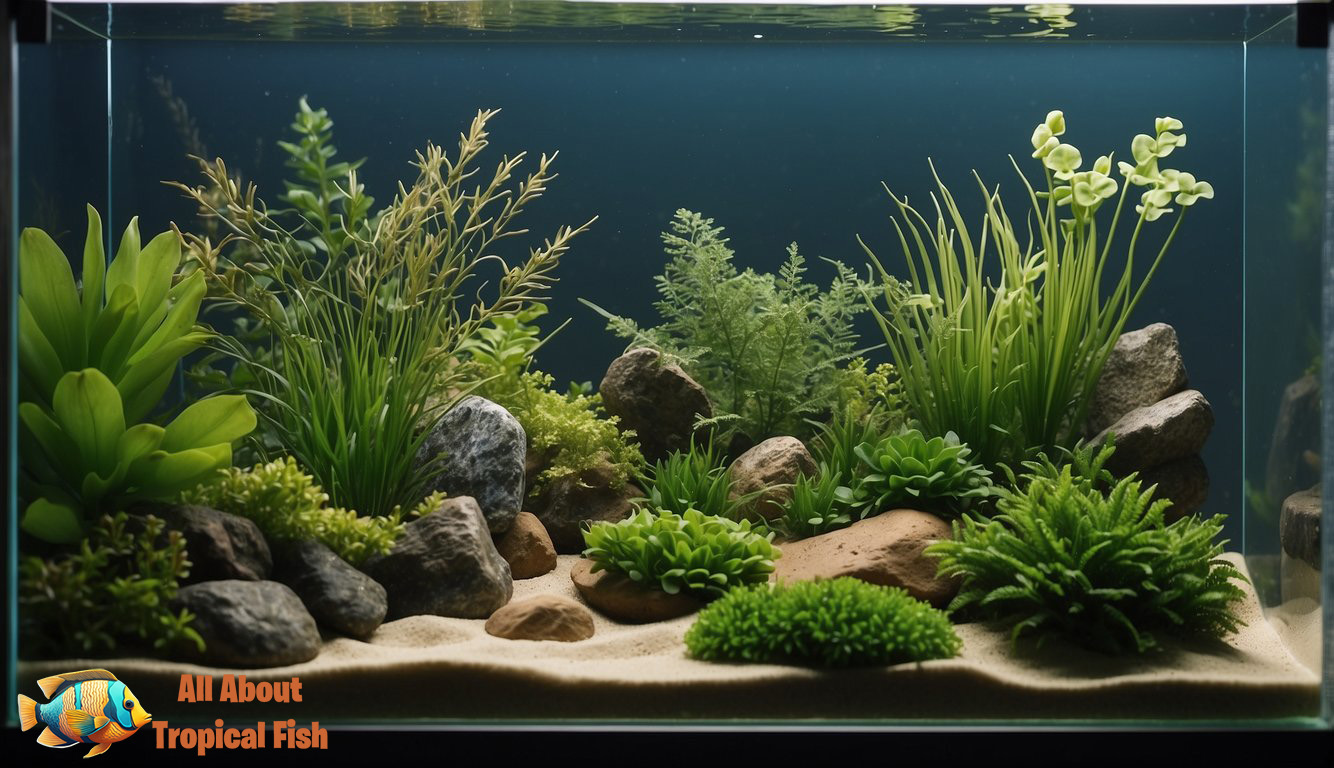
Aquascaping is both an art and a science, requiring creativity and an understanding of how to build a visually compelling underwater landscape. Attention to design, selection of materials, and plant placement all play pivotal roles in creating an aesthetically pleasing planted aquarium.
Creating the Layout
Begin by sketching out your design to determine the placement of key elements. Your layout should include a focal point, which serves as the center of attraction in the aquascape. To enhance the sense of depth and height, position larger items like rocks or driftwood towards the back and scale down as you move forward. Creating a sloping effect from the back to the front can also amplify the perception of depth.
Selecting Materials
The materials you choose, such as stones, driftwood, and other hardscape materials, should complement each other and fit within the desired theme of your aquascape. Using odd numbers of stones or pieces of wood can create a more natural and harmonious appearance.
- Rocks: Select rocks with varying sizes but similar color and texture.
- Driftwood: Choose pieces that lend themselves to the unique contours of your design.
Incorporating Plants
Plants breathe life into your aquascape. Mixing different types, like foreground carpeting plants, with taller stem plants in the back can create a visually intriguing contrast. Consider plant growth patterns and maintenance when placing each species. Java moss is a versatile plant that can attach to rocks or driftwood and create a lush green effect.
Achieving Aesthetically Pleasing Balance
Arrange your materials and plants to create visual harmony within the tank. Pay attention to balancing light and shadow, and consider the rule of thirds to position your focal point effectively. This directional flow leads the viewer’s eye through the scene naturally.
- Foreground: Use low-growing plants to avoid cluttering the view.
- Background: Taller plants should complement the hardscape without overshadowing focal points.
Using Lighting Effectively
Lighting is pivotal in highlighting the beauty of your aquascape. Aquarium lighting should cater not just to aesthetic appeal but also to the needs of your plants.
- Intensity and Color: Different plants require various light intensities, and the color temperature can affect how the colors in your aquascape are perceived.
- Shadows and Highlights: Position lights to create gentle shadows and soft highlights, enhancing the nature style of your aquascape.
Practical Aspects of Aquascaping
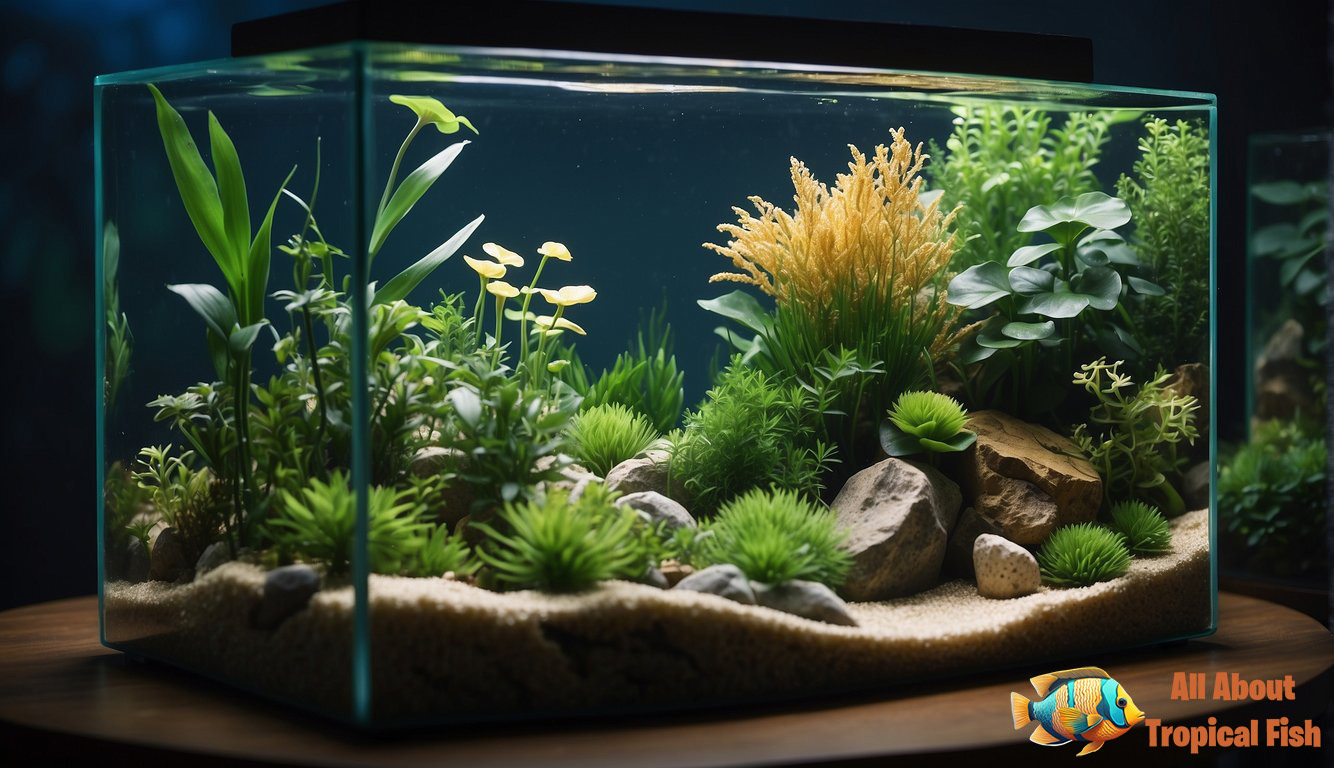
Aquascaping requires a blend of creativity and an understanding of the practicalities of maintaining an underwater garden. To ensure your artwork thrives, you’ll need to pay close attention to the setup and ongoing care of your aquarium. Here’s what you need to focus on:
Aquarium Setup and Maintenance
When setting up your aquarium, choose the right size for your space and the complexity of the aquascape you envision. Substrates serve as the foundation of your aquascape, and options include soil, gravel, or sand, each supporting plant growth in different ways. After your aquarium is set up, regular maintenance tasks include cleaning the glass, trimming plants, and monitoring water parameters to ensure a healthy environment.
Filtration and Water Quality
A top-notch filtration system is essential, as it keeps the water clear and removes waste. Aquarium filters come in various types including hang-on-back (HOB), canister, sponge, and under-gravel. Ensure your water filter is rated for your tank’s volume. Water chemistry is also paramount; you must regularly test and adjust parameters such as pH, ammonia, nitrates, and nitrites.
Nutrient and CO2 Management
Plants need proper nutrients to grow, including nitrogen, phosphorus, potassium, and trace elements. Liquid fertilizers can be added to supply these nutrients. Carbon dioxide (CO2) is also crucial for plant growth and health. CO2 can be injected into your tank using a pressurized system, ensuring that plants undergo photosynthesis effectively.
- Nutrient Dosing:
- Macro-nutrients (NPK): According to plant requirements
- Micro-nutrients: Use prepared mixes as directed
Common Challenges and Solutions
Every aquarist encounters challenges. Algae outbreaks are common and can be curbed by managing light levels, avoiding overfeeding, and maintaining water quality. When selecting plants, it’s important to understand their care needs and growth patterns to prevent overcrowding and competition.
- Troubleshooting Tips:
- Algal Bloom: Reduced lighting periods, frequent water changes
- Cloudy Water: Check filtration system, consider water clarifiers
- Plant Health: Verify nutrient dosing, adjust CO2 levels
Aquascaping Techniques
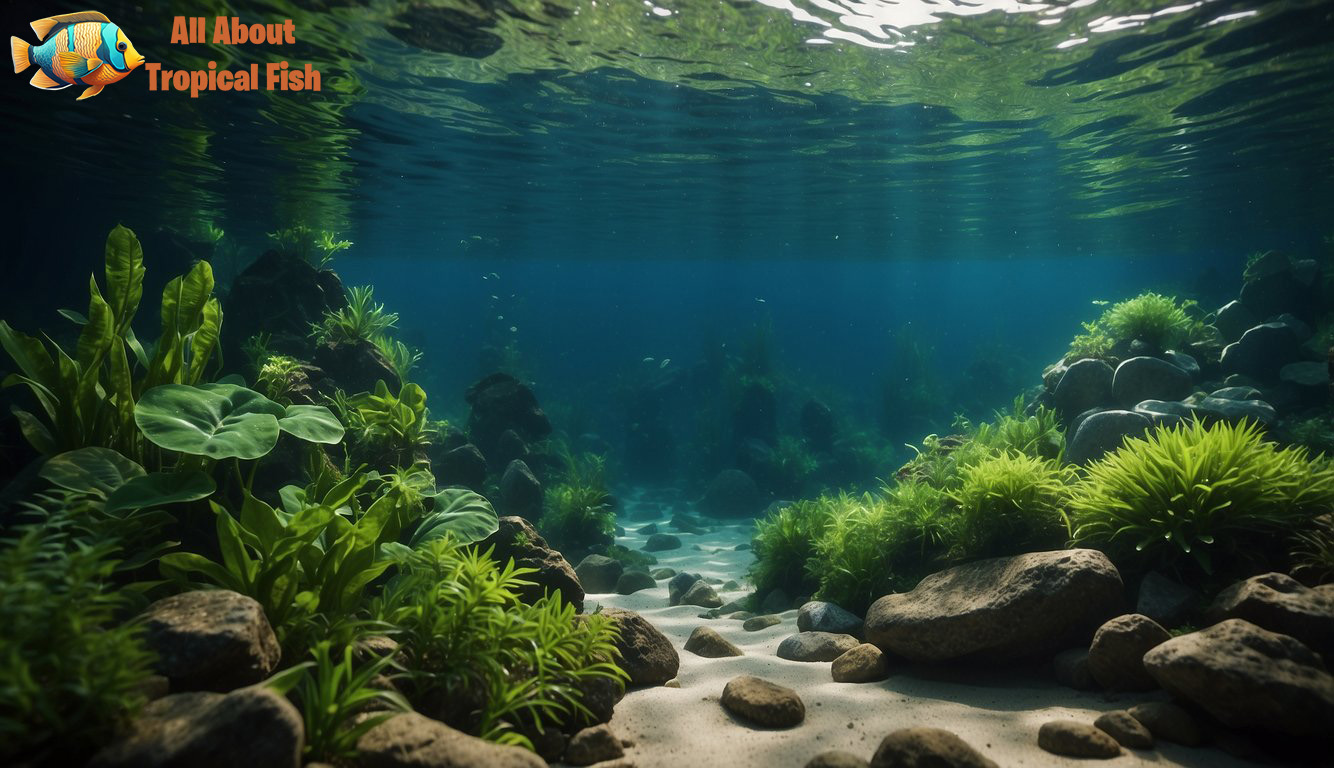
You’ll discover that each technique offers a unique approach to arranging your aquatic plants, rocks, and substrate. Mastering these methods allows you to transform your aquarium into a miniature underwater landscape.
Iwagumi Techniques
Iwagumi Style is centered on simplicity and open space, aiming to mimic natural rock formations. This style typically uses an odd number of rocks, with the largest, known as the ‘Oyaishi,’ serving as a focal point. Your rock placement should follow a thoughtful layout that guides the viewer’s eye and creates a sense of balance.
- Main Rocks: Oyaishi (largest), Soeishi (auxiliary), Fukuishi (secondary)
- Substrate: Often involves a terracing approach to create depth.
- Plant Choice: Minimalist, often with carpeting plants to accentuate the stones.
The Dutch Approach
Dutch Aquascaping focuses on a rich variety of plants, characterized by vibrant colors and contrasting textures. Unlike Iwagumi, this method embraces complexity and encourages you to meticulously organize and maintain distinct groupings of plant species.
- Layout: Plants are arranged in terraces or on different levels to create depth.
- Maintenance: Requires careful pruning to uphold the terraced layers and cluster separation.
- Paths: Clear space or sand paths can be used for a neat appearance amidst the lush vegetation.
Creating a Jungle Aquascape
The Jungle Style is for those seeking a more untamed and dense look, simulating the lushness of a jungle. Here, you can let your creativity run wild, blending tall and short plants to craft valleys and hidden paths.
- Plant Density: Embrace variety for a fuller, more natural look.
- Driftwood & Rocks: Use these to mimic the randomness of nature and to provide structure.
- Layering: Place taller plants towards the back to create the illusion of depth.
Advancing Your Aquascaping Skills
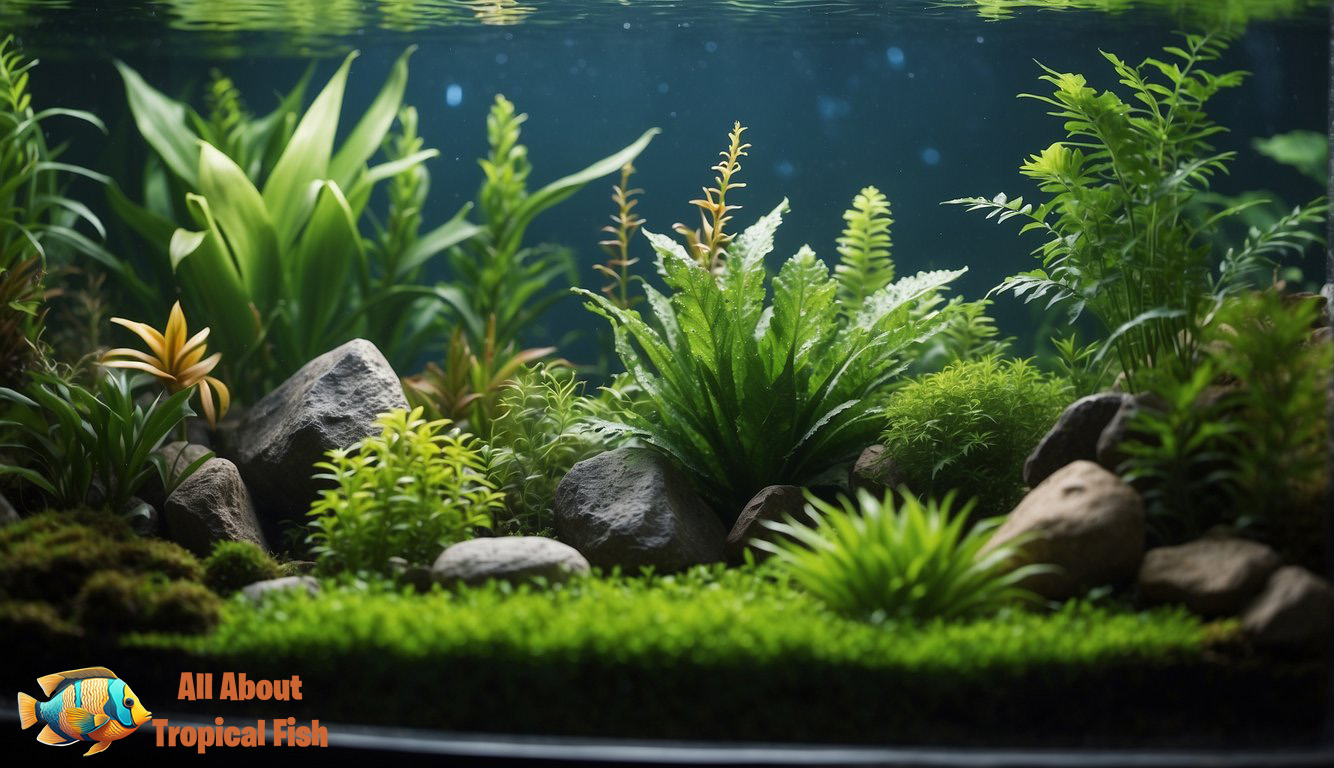
Elevating your aquascaping from a simple pastime to an art form requires an understanding of key techniques and concepts. As you refine your craft you’ll be able to create an underwater landscape that is both aesthetically pleasing and sustainable.
Performing Effective Aquascaping
Hobbyists looking to advance their skills should focus on low-tech setups initially. These offer a less complex system that is easier to manage and perfect. Progressing to nature aquascapes, which mimic natural environments, can provide an artful underwater landscape with strategic placement of hardscape materials such as rocks and wood. Effective maintenance routines, including regular water changes and pruning, will ensure your aquascape remains healthy and visually stunning.
Remember, uniformity is not the goal; instead, aim for a balanced, dynamic design that guides the eye through the composition.
From Hobbyist to Artist
Transitioning from a hobbyist to an artist in the realm of aquascaping means going beyond the basics. You must develop an eye for design and the ability to craft focal points that draw attention. Consider elements of nature aquascaping to create replicas of natural landscapes. Experiment with different plant species, stone types, and wood to achieve a unique and artful underwater landscape.
Remember:
- Balance: Keep the rule of thirds in mind for a harmonious layout.
- Focal Points: Introduce bold elements or colorful plants to create areas of interest.
Persistence and Simplicity
Persistence is vital in aquascaping. Your skills will sharpen over time with practice and patience. Simplicity can often lead to the most beautiful results. Rather than overcrowding your tank with various elements, focus on a few strong, well-maintained pieces to stand out. Pay attention to the growth patterns and needs of your plant life; sometimes the most stunning planted aquariums are the result of restrained, yet thoughtful, choices.
To embrace simplicity and persistence:
- Edit: Regularly evaluate your design, removing or adding elements as needed.
- Observe: Learn from the natural growth and interactions within your tank to inform future designs.
By developing your skills, you have the opportunity to transform your aquascape into a serene and inviting underwater landscape that reflects both nature’s beauty and your personal creativity.
Resources for Aquascapers
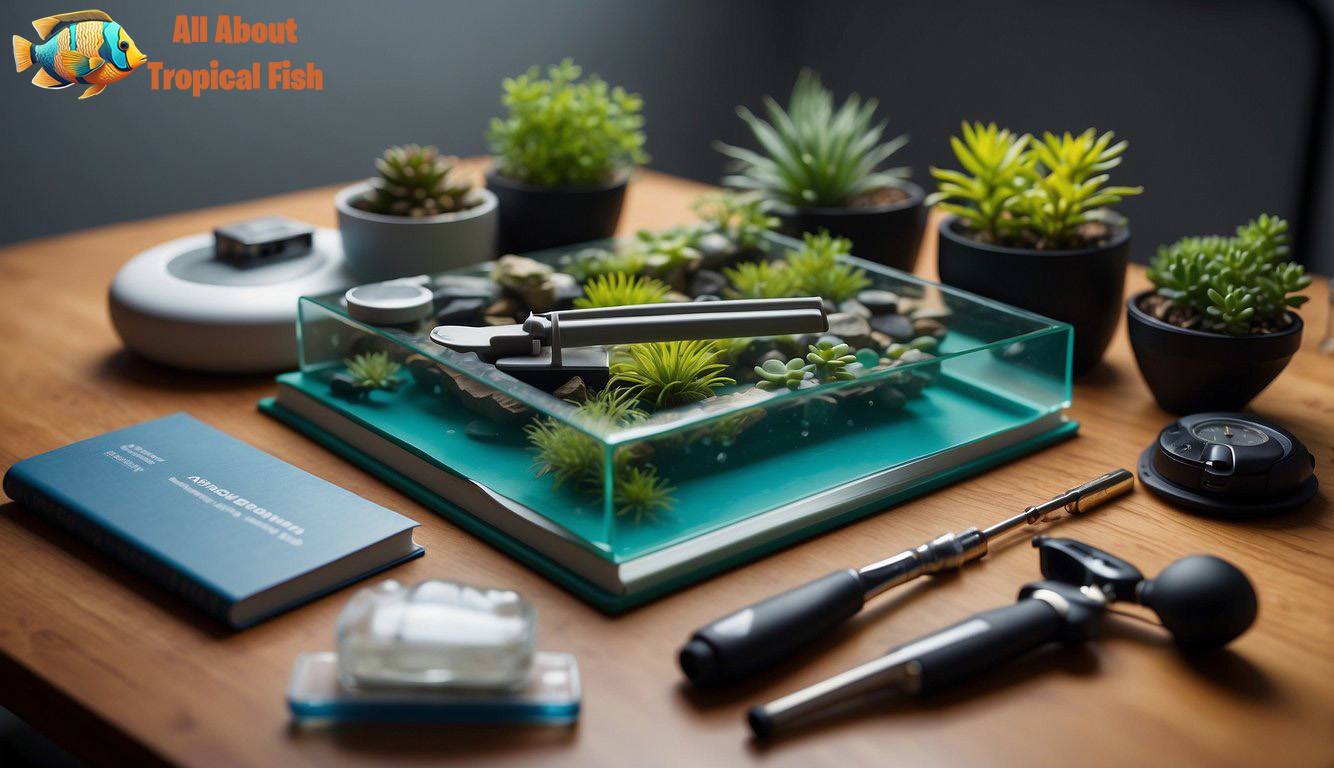
Engaging in the hobby of aquascaping is more than just arranging a tank; it’s a continuous learning process and a creative journey. Here’s where you can find support, tools, and education to enhance your productivity and skills in creating underwater landscapes.
Community and Inspirational Sources
Your journey into aquascaping can be both exciting and daunting, but you’re not alone. Aquascaping communities are rich with inspiration and support. Forums and social media groups are great places to start. Engage with peer aquascapers and learn from their experiences. For a surge of creativity, explore works by renowned aquascapers like Takashi Amano, who popularized the nature aquarium and the use of the delicate Japanese style.
Tools of the Trade
Equipping yourself with the right tools can transform your aquascaping experience. For precision work, like planting or arranging substrate, tweezers are indispensable. Invest in a selection of quality substrates that provide essential nutrients for your plants and help maintain your tank’s ecosystem.
- Basic Tools: Tweezers, scissors, algae scrapers
- Substrates: ADA Aqua Soil, Seachem Flourite
- Maintenance Kits: Complete kits usually include tweezers, scissors, and sometimes specialized cleaning tools.
Educational Materials and Workshops
Expand your knowledge and refine your techniques by diving into a wealth of educational resources. Books and online courses cover everything from plant selection to the design and maintenance phases of your aquascape. Workshops, often led by experts in the field, provide hands-on experience and personalized advice to improve your creative process.



Leave a Reply